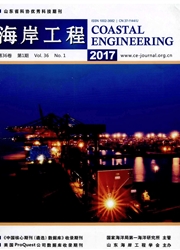

 中文摘要:
中文摘要:
A two-time-level,three-dimensional numerical ocean circulation model is established with a two-level,single-step Eulerian time-difference scheme.The mathematical model of the large-scale oceanic motions is based on the terrain-following coordinated,Boussinesq,Reynolds-averaged primitive equations of ocean dynamics.A simple but very practical Eulerian forward-backward method is adopted to replace the most preferred leapfrog scheme as the time-difference method for both barotropic and baroclinic modes.The forward-backward method is of the second order of accuracy,requires only once of the function evaluation per time step,and is free of the computational mode inherent in the three-level schemes.It is superior in many respects to the original leapfrog and Asselin-filtered leapfrog schemes in the practical use.The performance of the newly-built circulation model is tested by simulating a barotropic(tides in marginal seas of China)and a baroclinic phenomenon(seasonal evolution of the Yellow Sea Cold Water Mass),respectively.The three-year time histories of four prognostic variables obtained by the POM model and the two-time-level model are compared in a regional simulation experiment for the northwest Pacific to further show the reliability of the two-level scheme circulation model.
 英文摘要:
英文摘要:
A two-time-level, three-dimensional numerical ocean circulation model is established with a two-level, single-step Eulerian time-difference scheme. The mathematical model of the large-scale oceanic motions is based on the terrain-following coo-rdinated, Boussinesq, Reynolds-averaged primitive equations of ocean dynamics. A simple but very practical Eulerian forward-back-ward method is adopted to replace the most preferred leapfrog scheme as the time-difference method for both barotropic and barocli-nic modes. The forward-backward method is of the second order of accuracy, requires only once of the function evaluation per time step, and is free of the computational mode inherent in the three-level schemes. It is superior in many respects to the original leapfrog and Asselin-filtered leapfrog schemes in the practical use. The performance of the newly-built circulation model is tested by simula-ting a barotropic (tides in marginal seas of China) and a baroclinic phenomenon (seasonal evolution of the Yellow Sea Cold Water Mass), respectively. The three-year time histories of four prognostic variables obtained by the POM model and the two-time-level model are compared in a regional simulation experiment for the northwest Pacific to further show the reliability of the two-level scheme circulation model.
 同期刊论文项目
同期刊论文项目
 同项目期刊论文
同项目期刊论文
 期刊信息
期刊信息
